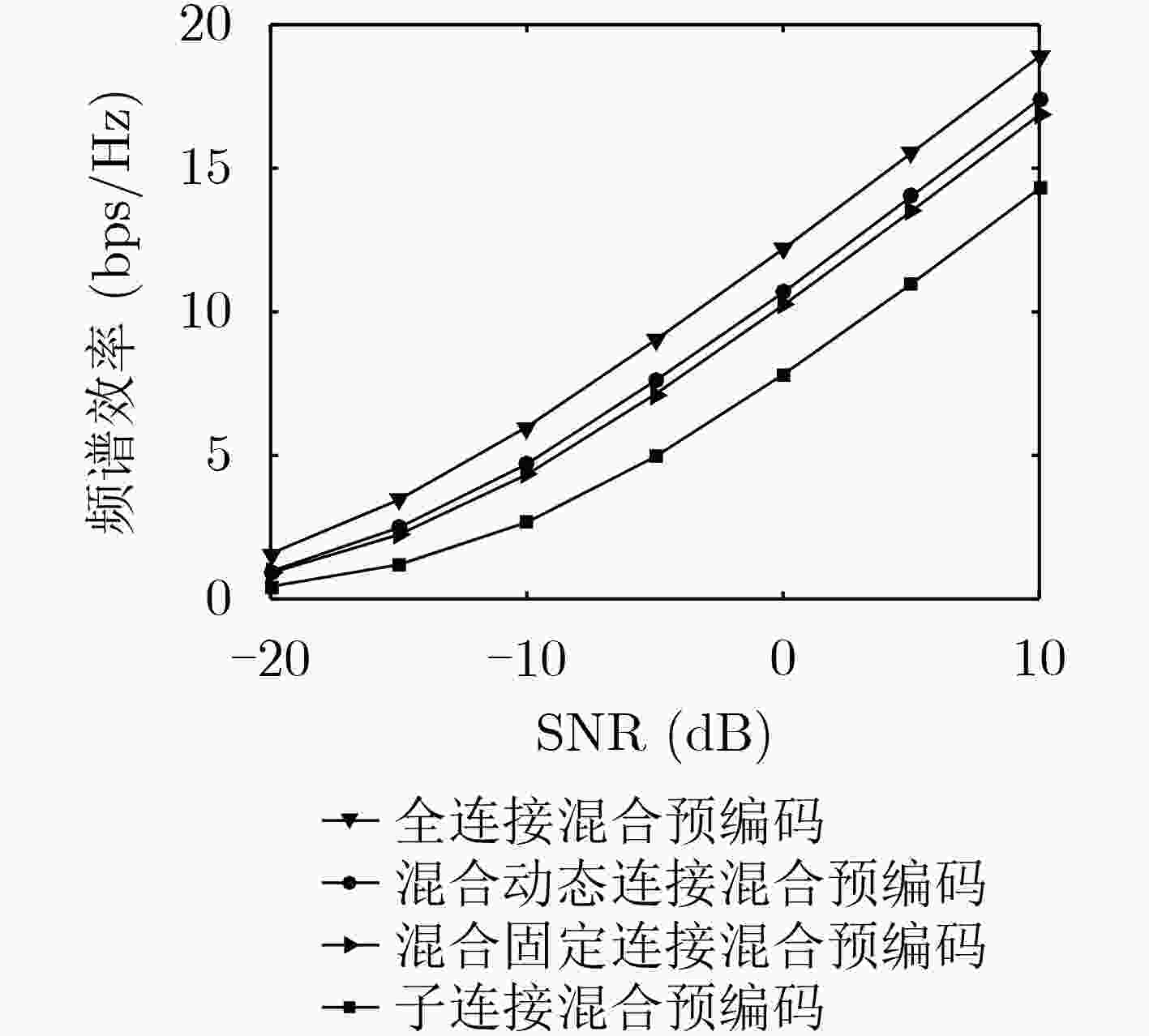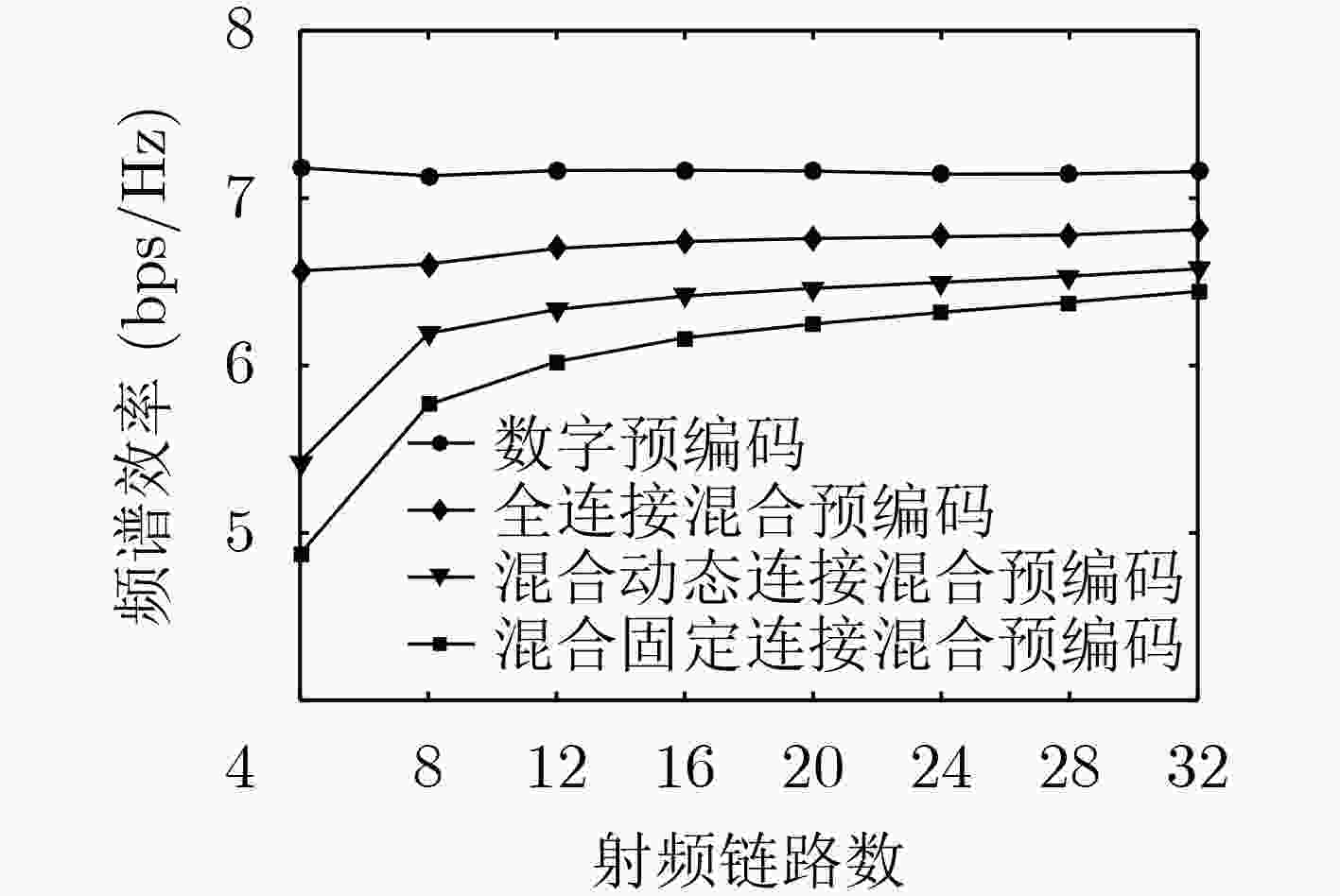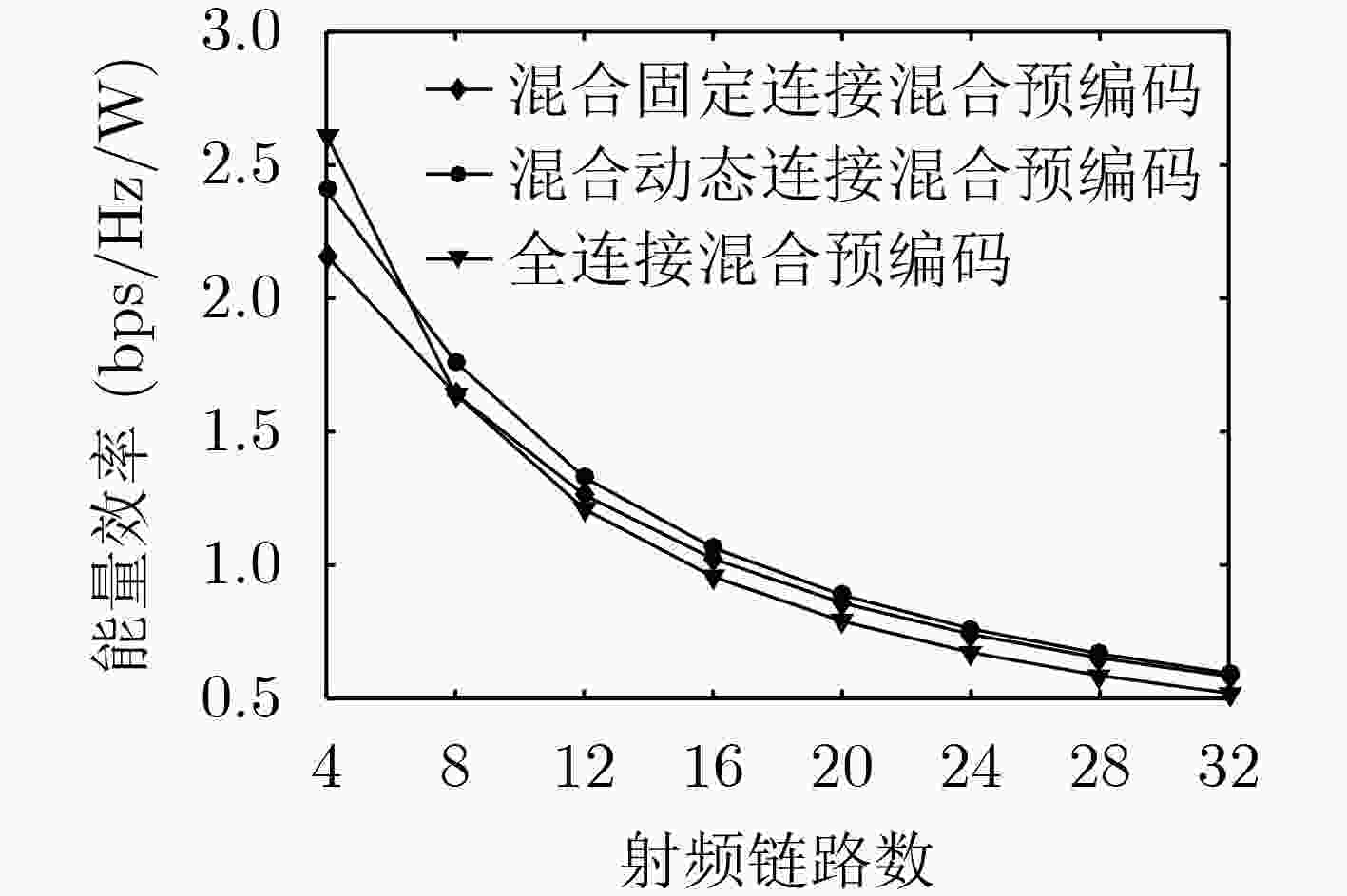Multi-user Multi-stream Hybrid Precoding with Hybrid Dynamic Connection Structure
-
摘要: 混合预编码对于提高多用户毫米波大规模多输入多输出(MIMO)系统的性能至关重要,但目前基于全连接结构与子连接结构的混合预编码分别存在高能耗与性能损失严重的问题。该文综合考虑系统的频谱效率与能量效率,提出混合动态连接结构,并设计该结构下的混合预编码算法。该算法通过最大化信干噪比(SINR)的增量来设计混合动态连接结构的模拟域预编码,然后基于等效信道运用块对角化(BD)设计数字域预编码抑制多用户多流干扰。仿真实验表明,该文所提出的混合动态连接结构的频谱效率介于全连接结构与混合固定连接结构之间且获得的能量效率最高。Abstract: Hybrid precoding is essential to improve the performance of multi-user millimeter-wave massive Multiple Input Multiple Output (MIMO) systems, but currently hybrid precoding based on fully connected structures and sub-connected structures have the problems of high energy consumption and severe performance loss, respectively. This paper comprehensively considers the spectral efficiency and energy efficiency of the system, proposes hybrid dynamic connection structure, and designs hybrid precoding algorithm under the structure. In this algorithm, the analog domain precoding of the hybrid dynamic connection structure is designed by maximizing the increment of Signal-to-Interference-plus-Noise Ratio (SINR), and then the digital domain precoding is designed by Block Diagonalization (BD) to suppress multi-user multi-stream interference through an equivalent channel. Simulation experiments show that the spectral efficiency of the proposed hybrid dynamic connection structure is between the spectral efficiency of the fully connected structure and the spectral efficiency of the hybrid fixed connection structure, but the highest energy efficiency is obtained.
-
Key words:
- Massive MIMO /
- Millimeter wave /
- Hybrid precoding /
- Hybrid dynamic connection structure
-
表 1 混合动态连接结构的多用户多流模拟域预编码设计算法
输入:$ {\boldsymbol{F}} $,${N_{\rm{t}}}$,$ {N_{\rm{RF}}} $,$ N $,$ K $ 输出:$ {{\boldsymbol{F}}_{\rm{RF}}} $ 初始化:${\boldsymbol{S} } = {\rm{zeros} }\left( { {N_{\rm{RF} } } } \right)$ for n=1:Nt for k=1:K
$ {\rm{SINR} }\left[ { { {\boldsymbol{S} }_k}{\text{ = } }{\boldsymbol{B} } } \right] = \frac{ {\dfrac{P}{ {K{N_{\rm{u} } } } }\left\| { { { {\tilde{\boldsymbol h} } }_k}{\boldsymbol{F} }{ {\boldsymbol{S} }_k} } \right\|_{\rm{F} }^2} }{ { {\delta ^{2} } + \dfrac{P}{ {K{N_{\rm{u} } } } }\displaystyle\sum\nolimits_{j \ne m} {\left\| { { { {\tilde{\boldsymbol h} } }_k}{\boldsymbol{F} }{ {\boldsymbol{S} }_j} } \right\|_{\rm{F} }^2} } } $${\rm{SINR} }\left[ { { {\boldsymbol{S} }_k}{\text{ = } }{\boldsymbol{A} } } \right] = \frac{ {\dfrac{P}{ {K{N_{\rm{u}}} } }\left\| { { { {\tilde{\boldsymbol h} } }_k}{\boldsymbol{F} }{ {\boldsymbol{S} }_k} } \right\|_{\rm{F} }^2} }{ { {\delta ^{2} } + \dfrac{P}{ {K{N_{\rm{u}}} } }\displaystyle\sum\nolimits_{j \ne m} {\left\| { { { {\tilde{\boldsymbol h} } }_k}{\boldsymbol{F} }{ {\boldsymbol{S} }_j} } \right\|_{\rm{F} }^2} } }$ end $ {\nabla _k} = {\rm{SINR}}\left[ {{{\boldsymbol{S}}_k}\left( {n,:} \right) = {\boldsymbol{A}}} \right] - {\rm{SINR}}\left[ {{{\boldsymbol{S}}_k}\left( {n,:} \right) = {\boldsymbol{B}}} \right] $ ${\boldsymbol{S}}_k^ * {\text{ = } }\mathop {\arg \max }\limits_{ { {\boldsymbol{S} }_k} } {\nabla _k}$ $ {\boldsymbol{S}}\left( {n,N\left( {k - 1} \right) + 1} \right) = {\boldsymbol{S}}_k^ * $ end $ {{\boldsymbol{F}}_{\rm{RF}}} = {\boldsymbol{FS}} $ -
[1] EL AYACH O, RAJAGOPAL S, ABU-SURRA S, et al. Spatially sparse precoding in millimeter wave MIMO systems[J]. IEEE Transactions on Wireless Communications, 2014, 13(3): 1499–1513. [2] YU Xianghao, SHEN J C, ZHANG Jun, et al. Alternating minimization algorithms for hybrid precoding in millimeter wave MIMO systems[J]. IEEE Journal of Selected Topics in Signal Processing, 2016, 10(3): 485–500. [3] XING Yaxin, CHEN Yueyun, and YANG Liuqing. MMSE-based wideband hybrid precoding for massive MIMO systems[C]. 2016 International Conference on Information and Communication Technology Convergence (ICTC), Jeju, Korea, 2016: 18–20. [4] 解培中, 孙锐, 李汀, 等. 基于连续干扰消除的毫米波MIMO系统混合预编码算法[J]. 电子与信息学报, 2019, 41(2): 409–416. doi: 10.11999/JEIT180379XIE Peizhong, SUN Rui, and LI Ting. Hybrid precoding algorithm based on successive interference cancellation for millimeter wave MIMO systems[J]. Journal of Electronics &Information Technology, 2019, 41(2): 409–416. doi: 10.11999/JEIT180379 [5] SOHRABI F and YU Wei. Hybrid digital and analog beamforming design for large-scale antenna arrays[J]. IEEE Journal of Selected Topics in Signal Processing, 2016, 10(3): 501–513. [6] KONG Lingxiao, HAN Shengqian, and YANG Chenyang. Hybrid precoding with rate and coverage constraints for wideband massive MIMO systems[J]. IEEE Transactions on Wireless Communications, 2018, 17(7): 4634–4647. [7] LING Le, XU Wei, and DONG Xiaodai. Low-complexity hybrid precoding in massive multiuser MIMO systems[J]. IEEE Wireless Communications Letters, 2014, 3(6): 653–656. [8] 黄天与, 马林华, 胡星, 等. 一种适用的毫米波大规模MIMO混合预编码算法[J]. 电子与信息学报, 2017, 39(8): 1788–1795. doi: 10.1199/JEIT161211HUANG Tianyu, MA Linhua, HU Xing, et al. Practical hybrid precoding algorithm for millimeter wave massive MIMO[J]. Journal of Electronics &Information Technology, 2017, 39(8): 1788–1795. doi: 10.1199/JEIT161211 [9] DAI Linglong, GAO Xinyu, QUAN Jinguo, et al. Near-optimal hybrid analog and digital precoding for downlink mmWave massive MIMO systems[C]. 2015 IEEE International Conference on Communications (ICC), London, UK, 2015: 1334–1339. [10] NI Weiheng and DONG Xiaodai. Hybrid block diagonalization for massive multiuser MIMO systems[J]. IEEE Transactions on Communications, 2016, 64(1): 201–211. [11] DAI Linglong, GAO Xinyu, and WANG Zhaocheng. Energy-efficient hybrid precoding based on successive interference cancelation for millimeter-wave massive MIMO systems[C]. 2015 Radio and Antenna Days of the Indian Ocean (RADIO), Belle Mare, Mauritius, 2015: 1–2. [12] ZHANG Zhilong, WU Xiaoyong, and LIU Danpu. Joint precoding and combining design for hybrid beamforming systems with subconnected structure[J]. IEEE Systems Journal, 2020, 14(1): 184–195. [13] JIANG Jing, YUAN Yue, and ZHEN Li. Multi-user hybrid precoding for dynamic subarrays in mmWave massive MIMO systems[J]. IEEE Access, 2019, 7: 101718–101728. [14] LIU Yang, FENG Qingxia, WU Qiong, et al. Energy-efficient hybrid precoding with low complexity for mmWave massive MIMO systems[J]. IEEE Access, 2019, 7: 95021–95032. [15] ZHANG Didi, WANG Yafeng, LI Xuehua, et al. Hybridly connected structure for hybrid beamforming in mmWave massive MIMO systems[J]. IEEE Transactions on Communications, 2018, 66(2): 662–674. [16] CHEN Yun, CHEN Da, JIANG Tao, et al. Millimeter-wave massive MIMO systems relying on generalized sub-array-connected hybrid precoding[J]. IEEE Transactions on Vehicular Technology, 2019, 68(9): 8940–8950. [17] RAPPAPORT T S, GUTIERREZ F, BEN-DOR E, et al. Broadband millimeter-wave propagation measurements and models using adaptive-beam antennas for outdoor urban cellular communications[J]. IEEE Transactions on Antennas and Propagation, 2013, 61(4): 1850–1859. [18] CUI Mingyang and ZOU Weixia. Low complexity joint hybrid precoding for millimeter wave MIMO systems[J]. China Communications, 2019, 16(2): 49–58. [19] HEATH R W, GONZÁLEZ-PRELCIC N, RANGAN S, et al. An overview of signal processing techniques for millimeter wave MIMO systems[J]. IEEE Journal of Selected Topics in Signal Processing, 2016, 10(3): 436–453. -






 下载:
下载:






 下载:
下载:
